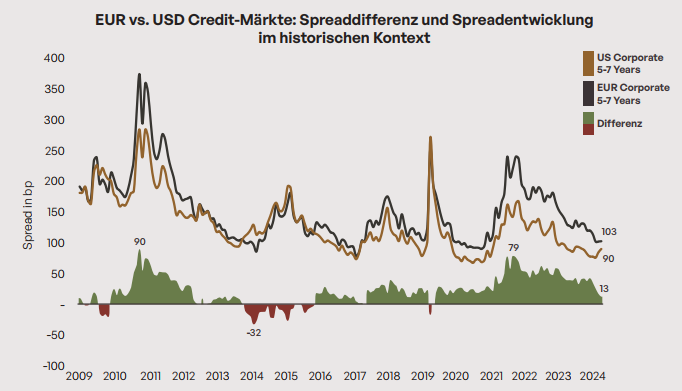
Steffen Ullmann
Senior Portfolio Manager – Investment Grade
The EUR credit market has recovered significantly since the beginning of the year. Spreads have fallen from 95 basis points to 79 basis points in the meantime – even geopolitical uncertainties and structural fiscal changes in Germany have not slowed this trend. At the same time, the spread to USD credit markets has narrowed to a historically low level. But is this a sign of strength – or a warning signal?
EUR Credit remains unimpressed by recent developments
The EUR credit market has proved resilient in the year to date. Spreads have narrowed from 95 basis points to 79 basis points in the meantime – despite macroeconomic uncertainties and growing trade risks. The reaction to the latest fiscal policy developments in Germany is particularly noteworthy: the strongest one-day yield movement on German government bonds since 1990, triggered by the The announcement of a reform of the debt brake and an additional, debt-financed infrastructure program left the EUR credit market completely unimpressed.
Instead of a risk adjustment, spreads in the EUR credit market continued to narrow, while the opposite trend was seen in the USD credit market. Spreads widened there, causing the spread difference for 5-7-year maturities to shrink to just 13 basis points – a level that has not been reached for a long time, apart from the market turmoil during the COVID crisis.
These contrasting movements raise the question of whether this is a structural revaluation or whether the latest development is a warning signal for the EUR credit market

Source: Bloomberg, Euro-Aggregate: Corporate – 5-7 Year (H02136EU Index) and US Corporate 5-7 years (I13282 Index), own calculation; time period: 31.12.2009 to 21.03.2025.
Political uncertainty in the USA as a driver of spread widening
The reduced spread difference is primarily due to the fact that USD spreads have widened as a result of extreme political uncertainty regarding the new US administration. Growing concerns about protectionist measures, regulatory intervention and their negative impact on US growth have weighed on investor confidence and led to a reassessment of credit risks in the US.
While the EUR credit market continued to narrow in an environment driven by technical demand, the widening of USD spreads reflects increasing uncertainty about the direction of US economic policy. These uncertainties could also spread to the global credit market and affect the EUR credit market in the medium term.
This is particularly relevant as 28% of issuers in the EUR Credit market come from the US and are therefore primarily dependent on the US economy. In addition, many European companies generate a large proportion of their sales outside Europe, as the EU is an export region without a strong domestic market. If US growth comes under further pressure, this could affect not only US issuers, but also export-oriented European companies – with corresponding consequences for the EUR Credit market
Spreads, stimulus and structural problems: Where is the EUR credit market heading?
While fiscal stimulus in the form of new debt programs could provide positive growth impetus in Europe in the medium term, the US and global economy remains the decisive factor for the earnings performance of most companies in the short term.
In addition, the key question remains as to what measures Europe will take to strengthen its long-term growth potential through structural reforms. Fiscal stimuli and debt-financed programs may provide short-term growth, but they do not solve structural problems. Deregulation, the strengthening of the domestic market and more competitive location conditions are decisive levers for sustainable growth, but hardly play a role in the current economic policy debate. Without far-reaching reforms, the fiscal stimulus will only provide temporary support, while Europe’s structural weaknesses will persist in the long term.
In the short term, the US and global economy remains the dominant factor for the earnings performance of many companies. Although European companies with a domestic focus could benefit from fiscal stimulus in the medium term, there are clear consequences for the market as a whole as a result of current developments:
• The small spread difference makes the EUR credit market less attractive for spread attractive.
• The narrow spread difference could make a rotation into into USD credit markets more interesting again. again.
• Global growth momentum remains the decisive factor for the risk assessment of credit markets.
Should growth in the USA slow and protectionist tendencies increase, these effects could intensify and also weigh on the EUR Credit market.
EUR Credit remains vulnerable to global developments
The strong start to the year in the EUR credit market reflects a combination of stable fundamentals and technical demand. However, the convergence of the spread difference with the USD credit market is less a strength than a warning signal.
The resilience of the EUR Credit market in recent years is no coincidence, but a structural characteristic. The market is now more closely linked to the global economy than to the European domestic economy.
28 percent of issuers come from the USA, and many European companies generate the majority of their sales outside Europe. As a result, the market has been less affected by European economic downturns in recent years and has shown impressive stability.
This fundamental market structure will not change overnight. In the short term, the development of the global economy and the US economy will remain decisive. At the same time, it remains to be seen to what extent medium-term fiscal stimuli in Europe can provide sustainable growth impetus.
Risiken
Price losses due to increases in yields and/or higher risk premiums are possible. A total loss cannot be ruled out either.
Past performance is not an indication of future results, nor can future performance be guaranteed.
Disclaimer
This marketing communication within the meaning of the German Securities Trading Act is provided for information purposes only and should not be construed as personal investment advice or a recommendation or solicitation to buy, sell or hold any financial instrument or to adopt any investment strategy. The opinions and statements contained in this document reflect the current assessment at the date of publication. The information contained herein does not constitute a complete analysis of all material facts relating to any country, region or market. No financial analyses are prepared. Where statements are made about market developments, returns, price gains or other asset growth and risk figures, these are merely forecasts and we accept no liability for their occurrence. In particular, past performance, simulations or forecasts are not a reliable indicator of future performance. Assets can fall as well as rise. All information has been carefully compiled, in some cases with recourse to third-party information. Individual details may prove to be no longer or no longer fully accurate, in particular due to the passage of time, changes in the law or current market developments, and may change at any time without prior notice. No guarantee is therefore given for the correctness, completeness and up-to-dateness of all information. Please inform yourself independently about all costs relevant to you. Maintaining a custody account may incur costs; ongoing bank charges may also be incurred. Transaction costs depend on the asset class: For government bonds and collateralized bonds such as Pfandbriefe, they average around 0.02 percent, for corporate bonds 0.085 percent. For less liquid bonds, the transaction costs can also be significantly higher than 0.25 percent. It should also be noted that transaction costs can temporarily be significantly higher during periods of market stress. For all products sold by HAGIM, all relevant cost information is made available prior to purchase. The information is based on our assessment of the current legal and tax situation. Insofar as tax or legal matters are affected, these should be discussed by the addressee with its tax advisor or lawyer. Investments in financial instruments are associated with both opportunities and risks. The handling of conflicts of interest at HAGIM is described at https://www.ha-gim.com/rechtlichehinweise published on the Internet. The information contained herein is intended for Professional Clients and Eligible Counterparties only. This information document is not directed at US citizens or persons permanently resident in the USA, nor at legal entities domiciled in the USA, nor may it be distributed in the USA
